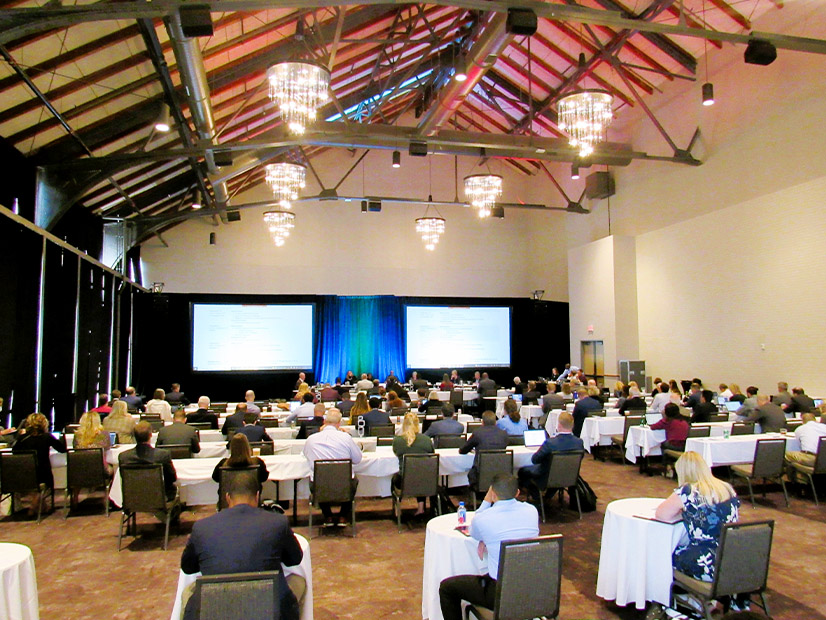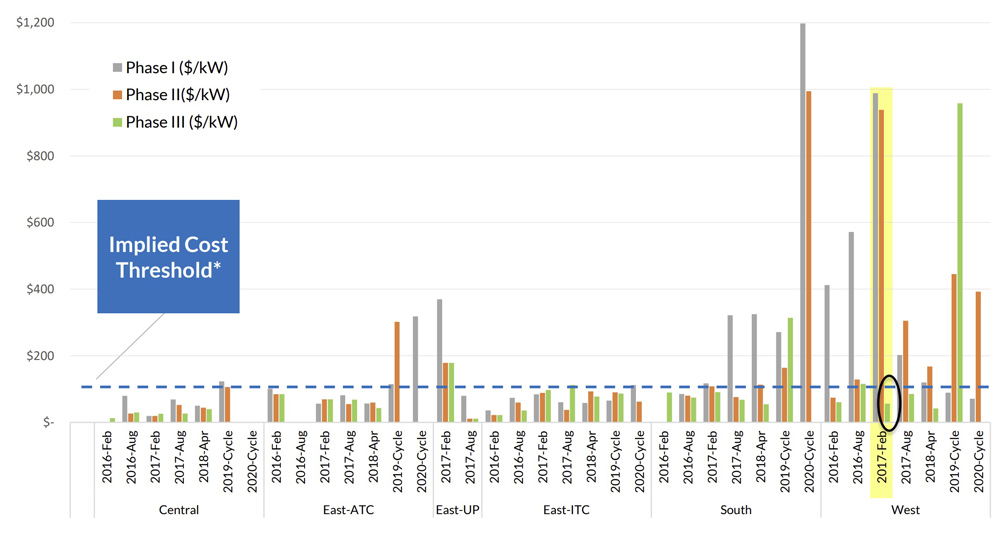
MINNEAPOLIS — MISO’s mid-September Board Week centered on the tectonic industry shift underway as the RTO plans to string more transmission lines across the footprint to bring record amounts of new capacity online and avert reliability crises.
Since the MISO Board of Directors’ last public meeting in June, the grid operator has opened its wholesale markets to full energy storage participation, approved more than $10 billion in long-range transmission lines, obtained FERC permission to conduct a seasonal capacity auction, and is preparing to study enough proposed capacity entering its generator interconnection queue to cover its current summer peak.
Transition a ‘Double Whammy’ Risk
MISO’s vice president of operations, Renuka Chatterjee, told directors during a Tuesday session that the footprint’s fleet evolution is having a “double whammy impact” on the RTO’s risk profile. She said increased renewable energy makes the grid more dependent on forecasting while baseload generation retirements hinder its ability to absorb their intermittency.
 MISO VP Renuka Chatterjee with Market Monitor David Patton | © RTO Insider LLC
MISO VP Renuka Chatterjee with Market Monitor David Patton | © RTO Insider LLCChatterjee said staff are working toward creating automated daily risk assessments that combine the interplay between solar and wind forecasts, load expectations, fossil fuel availability, net scheduled interchanges and transmission congestion. She said MISO will eventually introduce tailored daily reserve margin requirements.
The grid operator has committed to reviewing operating days that fall outside of historical norms to see if it needs to change its reliability preparations or new market products, Chatterjee said.
Jessica Lucas, executive director of system operations, said about 70% of MISO’s daily energy supply remains sourced from thermal generation, a concern before the national rail strike was apparently averted.
During the Thursday board meeting, CEO John Bear said the organization paid attention to CAISO operations during its early September heatwave. He said MISO trails California in the energy transition and noted that CAISO struggled with a lack of “controllable, long-duration resources” to weather the heat.
“We’ve got a good sense of where we need to go and how we need to get there,” Bear said.
More Tx to Yield Interconnections
Vice President of System Planning Aubrey Johnson said MISO expected more than 1,000 new generator interconnection requests, representing about 120 GW, for the 2022 cycle when the application window closed Thursday. He said it will be the third straight year staff have processed a record number of applications, each bigger than the previous.
Since 2014, MISO has received 329 GW of interconnection requests; 52 GW have progressed through to the generation interconnection agreement (GIA) stage that allows grid access. The grid operator currently has about 124 GW in the queue but has seen interconnection customers withdraw 153 GW over the past eight years. It hopes its recent transmission planning activity will drive up interconnection numbers and limit withdrawals.
“The last few years were relatively flat in terms generation additions and subtractions,” Johnson told board members during a Tuesday System Planning Committee meeting. “… What we’re seeing is an accelerated change in the resource mix, and it’s calling on us to do things differently.”
 Transmission upgrade costs and dropouts for interconnections by region for the 2016-2020 queue cycles | MISO
Transmission upgrade costs and dropouts for interconnections by region for the 2016-2020 queue cycles | MISO
MISO projects it will have 346 GW of nameplate capacity by 2042, but just under 200 GW in accredited capacity. The RTO currently has 201 GW in nameplate capacity and 173 GW in accredited capacity.
The grid operator is keenly aware that soaring network upgrade costs in parts of its footprint are hindering more generation additions. Interconnection projects tend to complete the queue when their associated transmission investments for interconnections are at or below $125/kW, Johnson said. However, upgrade costs have neared $1,000/kW or beyond in MISO’s West and South planning regions, eight times what investors are comfortable putting forward, he said.
“If you’re looking to interconnect in the Central region, come on in. The water’s warm,” Johnson said. “But if you’re looking to interconnect in the West or even the South, that’s a different matter.”
Johnson said transmission projects stemming from MISO’s Joint Targeted Interconnection Queue study with SPP should help yield more GIAs.
He said MISO is also immersed in identifying a second set of Midwestern transmission projects under its four-part long-range transmission plan (LRTP). The RTO obtained board approval in late July on the first, $10.4 billion set of LRTP projects in MISO Midwest.
“July 25 was a great day, but we’re going to continue to press on and define and develop what the next stage of projects is going to be … Much like football, we thought about the win for 24 hours, and then we moved on,” Johnson said.
The grid operator released the first competitive request for proposals stemming from the LRTP, a 345-kV line from an Indiana substation to the Michigan border. Proposals are due Jan. 11. The grid operator plans to release a new RFP for a different LRTP project about every three months and administer simultaneous bid evaluations.
Executives also said MISO allowed energy storage into its markets on Sept. 1 to comply with FERC Order 841. (See MISO Officially Opens Markets to Storage Resources.)
The grid operator characterized wholesale storage activity as nominal so far. But its interconnection queue currently has more than 13 GW of standalone battery storage as part of more than 150 projects in varying stages of development. That doesn’t include the queue’s hybrid generation projects, which usually pair renewable energy with a storage resource.
Unease over MISO Support for Gas Plant
Clean Grid Alliance’s Beth Soholt told board members that MISO has recently and unacceptably favored natural gas generation’s development over other resource types in bring new generation online. She said staff presentations following capacity shortages during the 2022-23 planning year advocated new gas-fired capacity, despite its fuel-neutral posture.
Soholt pointed to the RTO’s July letter to the Rural Utilities Service (RUS) in support of a loan for the proposed, $700 million gas-fired Nemadji Trail Energy Center in Superior, Wis., which would be jointly owned by Dairyland Power Cooperative and two Minnesota utilities.
In the letter, MISO said it was concerned about looming generation shortfalls and asked RUS to “consider grid reliability” and Nemadji Trail Energy Center’s role in the footprint’s resource adequacy.
“While MISO is both fuel- and technology-neutral, MISO needs to help ensure the best options to provide needed resource capabilities and attributes are available to bridge the gap between electrical baseload retirements and replacement capabilities and attributes,” Deputy General Counsel Kristina Tridico wrote.
Tridico said “the retirement of generation plants is occurring far faster than new energy sources with equivalent attributes, whatever the fuel source, can be developed, constructed and brought online.”
“While the letter was very careful to color within the lines of grid reliability, I’ve never seen MISO send a letter in a specific docket advocating for a specific new resource. This is not appropriate,” Soholt said during a public comment period Tuesday. “MISO has always said it is fuel and technology neutral, but a different message is coming through in the last several months of MISO messaging and presentations.”
Soholt said, “at the end of the day, there are many solutions to MISO’s resource adequacy challenges, and the work is not done yet.”
She urged MISO to not encourage members to rush headlong into natural gas solutions before it assesses battery storage’s flexible attributes in its market portfolio.
MISO executives didn’t respond to Soholt’s criticisms in real time during Board Week. In a later statement to RTO Insider, the grid operator said it believes the letter speaks for itself.
Staff and stakeholders will discuss the essential resource attributes it needs on the system during a System Attributes Introduction Workshop on Wednesday.



